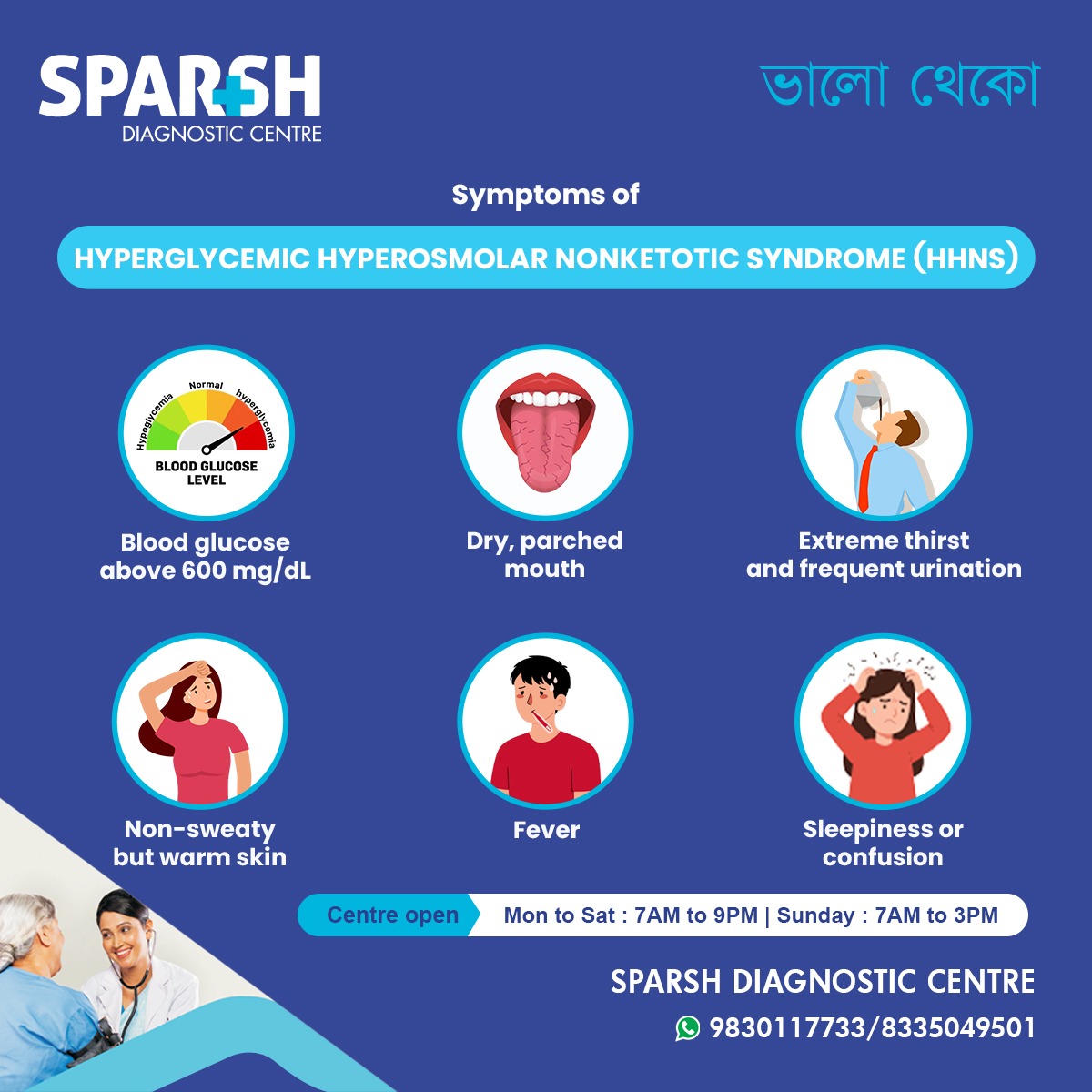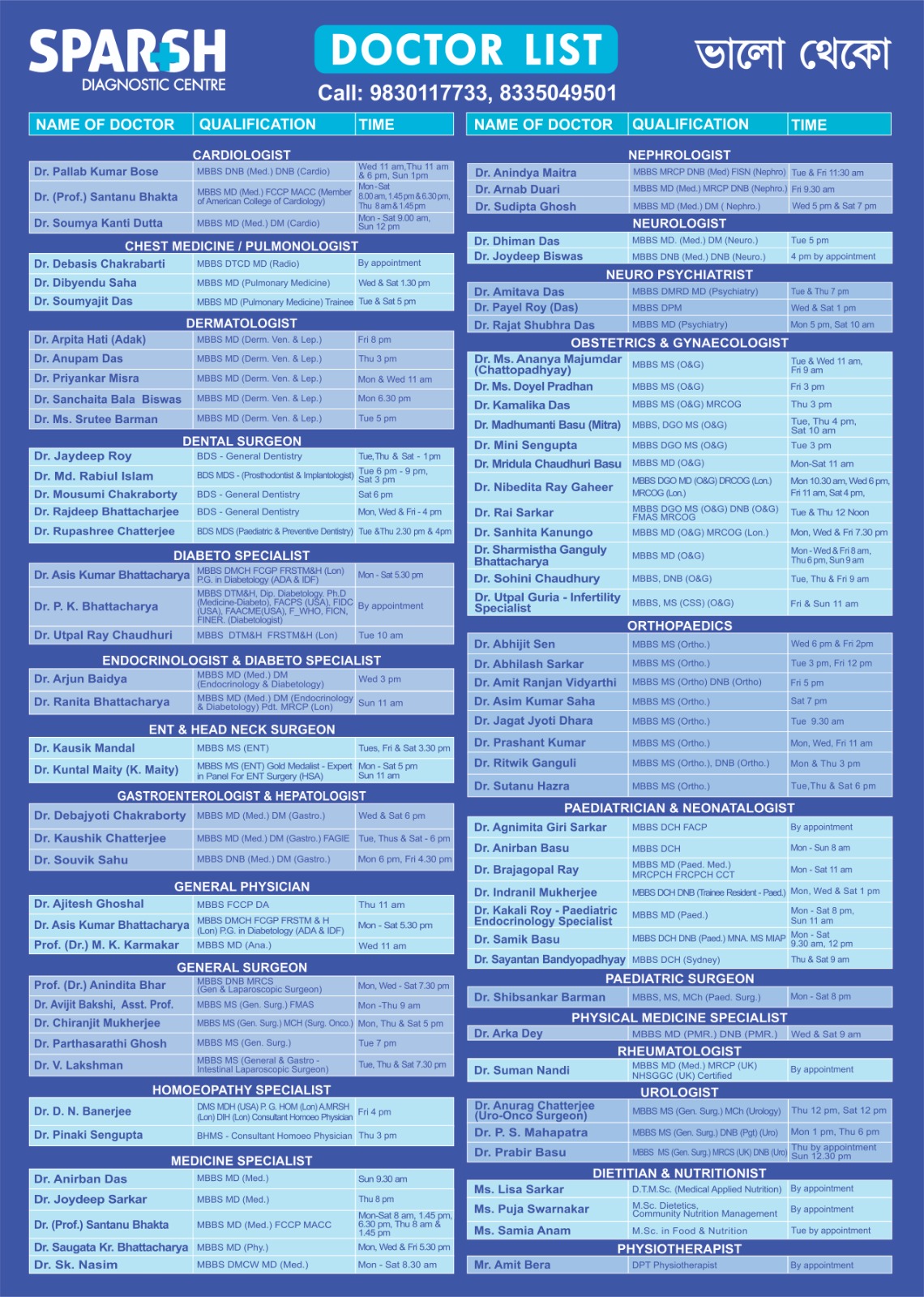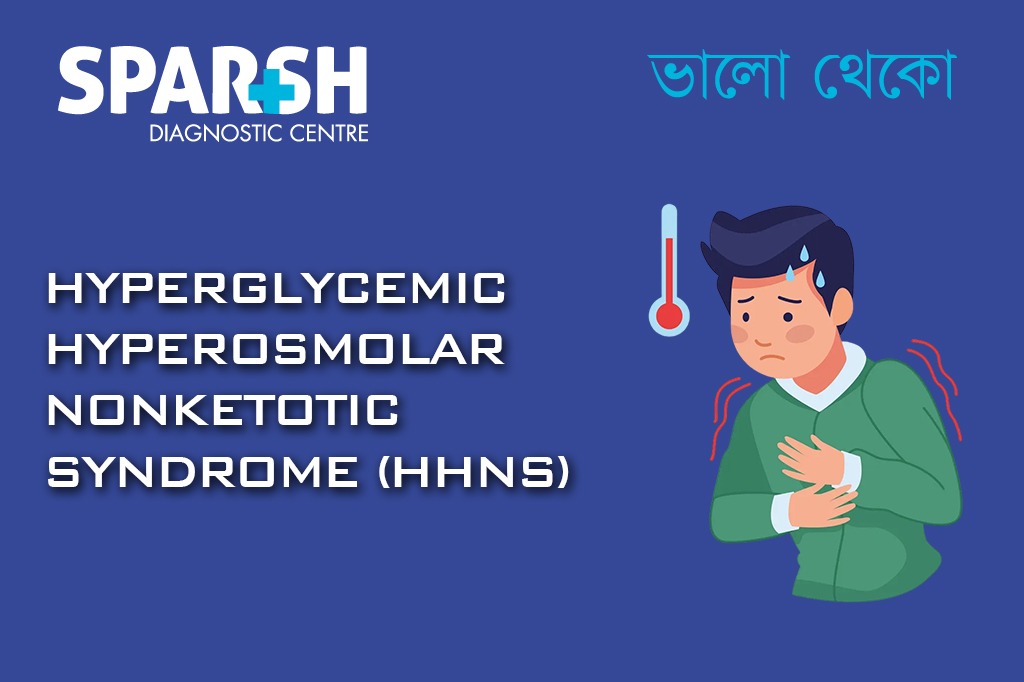Managing diabetes can be challenging, but being aware of its possible complications can help you stay safe and healthy. One such serious yet lesser-known complication is Hyperglycemic Hyperosmolar Nonketotic Syndrome (HHNS) — a life-threatening emergency that requires immediate medical attention.
At Sparsh Diagnostic Centre, we believe that awareness is the first step toward prevention. This blog explains everything you need to know about HHNS in a simple, patient-friendly manner — from understanding what it is, to recognizing its symptoms, knowing when to seek help, and learning how it can be prevented.
What is Hyperglycemic Hyperosmolar Nonketotic Syndrome (HHNS)?
Hyperglycemic Hyperosmolar Nonketotic Syndrome (HHNS) is a severe complication of diabetes mellitus, primarily affecting people with type 2 diabetes. It occurs when blood sugar levels rise dangerously high — often above 600 mg/dL — without the presence of significant ketones in the blood or urine.
This extreme elevation in blood glucose leads to severe dehydration, as the body attempts to eliminate excess sugar through frequent urination. Over time, this loss of fluids and electrolytes can result in confusion, seizures, or even coma if left untreated.
Unlike diabetic ketoacidosis (DKA), which commonly affects people with type 1 diabetes, HHNS does not cause ketone build-up. However, it can be equally dangerous and requires prompt medical treatment.
Who is at Risk of Developing HHNS?
HHNS typically develops gradually, often over several days or weeks. It most commonly occurs in:
Older adults with type 2 diabetes
Individuals with uncontrolled or undiagnosed diabetes
People suffering from infections such as pneumonia or urinary tract infections
Patients who have recently experienced strokes, heart attacks, or trauma
Those taking certain medications like steroids, diuretics, or antipsychotics that affect blood glucose levels
Individuals who are dehydrated due to illness or limited fluid intake
At Sparsh Diagnostic Centre, we regularly help patients monitor their blood sugar levels and manage their diabetes effectively — reducing the risk of such complications.
Symptoms of HHNS
Recognizing the symptoms early can be lifesaving. HHNS often begins with mild signs that gradually worsen.
The key symptoms of Hyperglycemic Hyperosmolar Nonketotic Syndrome include:
Blood glucose levels above 600 mg/dL
Such extremely high levels indicate a medical emergency requiring urgent attention.
Dry, parched mouth and excessive thirst
The body tries to flush out excess sugar, leading to dehydration and an unquenchable thirst.
Increased urination is one of the body’s defense mechanisms against rising glucose levels.
Non-sweaty but warm skin
Despite high body temperatures, sweating may be minimal, worsening dehydration.
Often a sign of an underlying infection or dehydration.
Sleepiness or confusion
The brain is highly sensitive to changes in fluid and glucose balance; confusion and fatigue are warning signs.
Extreme weakness and vision problems
Muscles and nerves begin to struggle as the body loses electrolytes and water.

If you or a loved one experience these symptoms, seek immediate medical help.
Causes of HHNS
HHNS develops when the body’s insulin is insufficient to regulate blood sugar levels properly. The common causes include:
1. Infections
Infections such as pneumonia, urinary tract infections, or sepsis are the most frequent triggers. The body’s stress response releases hormones that further raise blood sugar levels.
2. Certain Medications
Drugs like corticosteroids, diuretics, and antipsychotics can interfere with insulin function and increase glucose production.
3. Uncontrolled or Undiagnosed Diabetes
Many patients are unaware that they have diabetes until HHNS develops. Regular screening can prevent such situations.
4. Dehydration
Insufficient water intake, especially during hot weather or illness, can worsen blood sugar imbalance and lead to HHNS.
5. Recent Illness or Surgery
Illness, injury, or surgical stress increases insulin resistance and elevates blood glucose levels.
Diagnosis of HHNS
Diagnosis of HHNS begins with a detailed clinical evaluation and lab investigations.
The key diagnostic tests include:
Blood Glucose Test: Reveals extremely high blood sugar (above 600 mg/dL).
Serum Osmolality: Measures the concentration of substances in the blood, confirming dehydration.
Electrolyte Panel: Assesses imbalances like sodium and potassium levels.
Ketone Testing: Typically negative or only slightly elevated in HHNS, unlike in DKA.
Urinalysis: Checks for glucose and ketones in urine.
Blood Urea Nitrogen (BUN) and Creatinine: Help assess kidney function and dehydration severity.
Timely testing can save lives. Regular monitoring ensures early detection of abnormal glucose patterns.
Treatment of HHNS
HHNS requires immediate hospitalization. Treatment focuses on correcting dehydration, restoring normal blood sugar levels, and addressing the underlying cause.
1. Fluid Replacement
IV fluids help rehydrate the body, lower blood sugar concentration, and improve circulation.
2. Insulin Therapy
Administered intravenously to gradually bring down blood glucose levels to a safe range.
3. Electrolyte Correction
Essential electrolytes such as sodium, potassium, and chloride are carefully replaced to stabilize the body’s chemistry.
4. Treating the Underlying Cause
Infections or medication-induced HHNS are treated with antibiotics or dosage adjustments.
5. Monitoring and Supportive Care
Continuous monitoring of vital signs, blood sugar, and kidney function ensures safe recovery.
Possible Complications of HHNS
Without prompt treatment, HHNS can lead to:
This highlights the importance of recognizing early warning signs and seeking professional help immediately.
Prevention of HHNS
While HHNS is serious, it is largely preventable through careful diabetes management. Here are some key steps:
Monitor blood sugar regularly using a glucometer or at a diagnostic centre.
Stay hydrated, especially during illness, heat, or travel.
Take diabetes medication exactly as prescribed.
Manage infections promptly — consult a doctor if you develop fever or illness.
Follow a balanced diet recommended by your healthcare provider.
Schedule regular check-ups at Sparsh Diagnostic Centre to track glucose, kidney, and electrolyte levels.
Education, monitoring, and timely intervention are your best defense against HHNS.
Why Choose Sparsh Diagnostic Centre for Diabetes Care?
At Sparsh Diagnostic Centre, we are committed to providing accurate, affordable, and compassionate healthcare. Our services include:
Comprehensive diabetes profiles
Blood glucose and HbA1c testing
Kidney and electrolyte monitoring
Urinalysis and infection screening
Personalized patient guidance and follow-up care
Our patient-first approach ensures that every individual receives the right diagnosis at the right time — because at Sparsh, we believe in early detection, better outcomes, and long-term wellness.
Frequently Asked Questions (FAQ)
1. What is the difference between HHNS and diabetic ketoacidosis (DKA)?
Both are diabetic emergencies, but HHNS occurs mainly in type 2 diabetes and features very high blood sugar without significant ketones, while DKA is more common in type 1 diabetes and involves acid buildup due to ketones.
2. Can HHNS be reversed?
Yes. With prompt medical care, fluids, and insulin therapy, most patients recover fully. Early recognition and treatment are key.
3. How can I prevent HHNS if I have type 2 diabetes?
Regular monitoring, hydration, and timely treatment of infections are essential. Avoid skipping insulin or diabetes medications.
4. Is HHNS common?
HHNS is less common than DKA but tends to affect older adults or those with long-term, uncontrolled diabetes.
5. What blood sugar level is considered dangerous?
Any blood glucose reading above 400 mg/dL is concerning; levels above 600 mg/dL indicate a potential medical emergency like HHNS.
6. When should I visit a diagnostic centre?
If you experience extreme thirst, confusion, fever, or persistently high sugar readings, visit Sparsh Diagnostic Centre immediately for testing and consultation.
7. Can dehydration alone cause HHNS?
Dehydration doesn’t directly cause HHNS but can worsen high blood sugar and trigger the condition in diabetic individuals.
Hyperglycemic Hyperosmolar Nonketotic Syndrome (HHNS) is a serious yet preventable complication of diabetes. Awareness, regular monitoring, and timely medical intervention can make all the difference.
At Sparsh Diagnostic Centre, we are dedicated to helping patients take control of their health through early diagnosis, expert testing, and compassionate support.
If you or someone you know is living with diabetes, stay proactive — get your blood sugar checked regularly and know the warning signs of HHNS.
#BhaloTheko
Disclaimer:
No content on this site, regardless of date, should ever be used as a substitute for direct medical advice from your doctor or other qualified clinician.

![]()





